Seed saving is a way of preserving our botanical past and handing it on to future generations, just as we might pass down stories, songs or precious heirlooms. Good meets a couple who are making it their passion.
Words and photography Vivienne Haldane.

Growing food and saving heritage seed are the twin passions of Setha Davenport and her partner RoddyBranagan. It’s a interesting twist that a couple intent on preserving some of New Zealand’s unique botanical heritage are themselves recent arrivals to the country.
Setha has a degree in human ecology and sustainable agriculture from College of the Atlantic in Maine, USA, and came to New Zealand in 2001 for an internship on an organic farm in the Coromandel.
“I fell in love with the New Zealand countryside and farming and returned in 2005 to live,” she says. “I just wanted to learn how to grow food but it quickly dawned on me that you can’t really do that if you don’t know how to grow seed. That’s pretty much what I’ve been doing ever since I graduated.”
Roddy is originally from one of the Outer Hebrides Islands off the coast of Scotland. He describes himself as a jack of all trades – builder, electrician, chef, gardener and musician. “However, the best job I’ve ever had is growing vegetables,” Roddy says. “There is a lot of effort required getting beds ready for seedlings, weeding and watering, but it’s nothing compared to what you
get out of it.”
The couple met when Roddy recorded the choir Setha was a member of. At the time both were living in remote areas on the west coast of the South Island: Gentle Annie and Granity, respectively. Home these days is a humble little cabin on a Hawke’s Bay farm, and most days the couple can be found tending to their prolific gardens.

The holy bean
Every seed or bean comes with a story, and the holy bean is no exception. As Setha tells it, a French priest in World War I planted white beans on top of the church treasure to hide it from ransacking. “Come harvest time the beans had a black chalice shape on them, so he thought a miracle had occurred, and that’s how they got their name,” she says.
Setha’s business, Setha’s Seeds, was born out of her desire to preserve and share heritage seeds, as well as to encourage and support people to grow and save seed for themselves as a way of creating food security and resilience on a national level. Setha adds, “I love working in the garden, planning the plantings and making sure the soil is healthy so the food we grow is in turn keeping us healthy.” The couple sell their seeds online as well as at the local village market in Otane.

In the peaceful valley where Setha and Roddy live, an abundant crop of garlic stretches out in long rows, and a newly made compost heap is baking nicely, warmed by the spring sunshine. In another corner, a coop of chooks chortle happily while Setha checks for eggs.
During my visit, I’m invited inside the cabin where Roddy is busy making a yummy-smelling curry to take with them to an upcoming Wellington folk festival. Roddy loves to cook, and he also makes an excellent cup of tea: gumboot with one big spoonful of honey. On the wall hangs a line-up of musical instruments: mandolin, banjo and guitar. Setha and Roddy have their own Americana/country-style band called Cabin Fevre.
Later that afternoon, in a sweetly old-fashioned moment, a little girl from next door dashes up the driveway waving an envelope and announcing with a beaming smile, “You’ve got mail!”
How it’s done

1 Setha and Roddy use the ‘double digging’ method, which aerates the soil two spade-depths down. This allows the root systems of the plants to develop more deeply, therefore not needing as much space around them on the surface of the soil.
2 Each season they plant a high ratio of carbon crops – plants that produce a high amount of woody material such as corn, broad beans, sunflowers and grains. These crops are essential for good compost, which is the secret to building humus, the living soil all life depends on.
3 Mineral levels in the soil are checked using the Mulder’s Chart to make sure all the minerals are present in the right balance, something key to nutrient density and plant health.
Tips for seed saving
- If you are serious about seed saving, make sure your seed is open pollinated and not a hybrid seed. This information is generally on seed packets – F1 is hybrid. Open pollinated seed will have the Latin name included on the packet, or sometimes the abbreviation OP.

- The easiest way to start is with crops that self-pollinate such as peas, lettuce and tomatoes. With peas, for example, let the pods turn brown and crinkly, then harvest them.
- Dry seeds in an airtight container to prevent mould. Keep them out of direct sunlight in a cool place where there is air movement. Overheating kills seeds. “We often dry them in our cabin because it is warmer than outside,” says Setha. Food dehydrators with temperature gauges are ideal for drying seed overnight – use the lowest temperature setting.
- When perfectly dry, freeze the seed. This kills any bugs that might be living in bits of chaff that come with the seed. This is good practice, but not always necessary for the home gardener.
- There are two types of seed, wet and dry, which affect how you harvest and process it. For example, tomato seeds are wet (formed in the fruit and require drying out) but lettuce and pea seeds are dry (formed in the flower head then harvested).
- For wet seed, spread seeds on a paper towel or newspaper to dry before storing in an airtight container.An easy way for home gardeners to dry seed is to put seeds in a paper bag and store them in a hot water cupboard for three to five days, then transfer them to an airtight container.
- You can also try wet seed fermentation, which helps seeds last longer. Put wet seeds in an ice cream container or glass jar and add a little water. This ferments and breaks down the gel sack surrounding the seeds in three to five days, depending on the temperature. Wash, drain and dry – then seed is ready to plant.
- Some vegetables require growing the plant to full maturity before harvesting the seed, which is a bit different than growing a plant just to eat veggies. For example, courgette seeds are saved when they have grown to marrow size and are turning orange.
- Setha recommends keeping things simple to start with. “Try a few things that you know are self-pollinating – lettuces, for example, have both male and female flower parts in each flower.”
- For those who want an in-depth look at this ancient art, Setha recommends the book Seed to Seed by Suzanne Ashworth for comprehensive information on most vegetables grown in New Zealand.
What they grow
Setha and Roddy maintain 30 varieties of heritage European and Maori potatoes, three varieties of heritage New Zealand garlic and a host of other vegetables and flowers.
Their gardens are prepared using bio-intensive growing techniques, which allow for a higher yield per square metre while building soil fertility.
Email [email protected] for a seed catalogue, or visit www.facebook.com/sethasseedsnz to find out about garden tours, open days and markets where you can buy Setha’s Seeds







